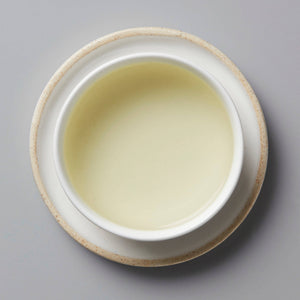Your Cart is Empty



SESSION LONGJING | green
$4.00 - $72.00
SESSION LONGJING is a longjing (i.e. dragonwell) from Xinchang county, Zhejiang province, China. The current lot is from April, 2023. Longjing from Xinchang is referred to as Da Fo ("Big Buddha") longjing, to differentiate it from West Lake longjing, the traditional cradle of this Chinese green tea. As we so often find, though, "traditional" is not categorically akin to "better"—in the case of West Lake, the majority of longjing gardens are situated near the major industrial centers of Hangzhou, which in our view bodes poorly for good tea cultivation (track air quality here). That's not always the case—there is no "always" in tea—but this year, an outstanding lot of longjing with a novel cultivar blend from Xinchang landed on our cupping table, and we once again preferred the oddball. The higher elevation, lack of synthetic agrochemicals, and clean rural environment certainly eases the conscience. Most critical, though, is the quality of production. SESSION LONGJING is not a one-of-a-kind longjing rich with variation, the artful imperfection of a handcraft, or charming flaws—it's technically perfect, as our producing partners at Xinchang Chengtan intended. Led by production masters Rende Jin and Jiangong Zhong (with a combined 75 years of longjing making experience), this lot was made by hand (many, many hands), but also with machines, and produced from end-to-end with rigorous quality control only possible in larger producing outfits. This isn't a mom & pop operation. And, in this case, the tea is better for it. Some teas—especially Japanese teas like sencha—benefit from consistency, and Chinese standards like longjing are no exception. The top 1% of microlot productions are indeed special, but the bulk of longjing is commodity tea, leaning on the West Lake brand name. Ours is honest: factory-produced longjing from Xinchang, made with clean material from gardens owned by the farming company. It's exceptional, but more importantly, provides a reliable experience. SESSION LONGJING is meant to be just that: clean, sweet, balanced, easy-drinking, and highly sessionable.
But on to the processing: what sets this lot apart is its peculiar cultivar blend. It's exactly 50% wu niu zao ("black ox early"), and 50% qunti ("groups"). Not an ounce of longjing #43 in sight, and that's on purpose—wu niu zao, the earliest budding of the longjing cultivars, is delicate, mellow and sweet, not unlike anji baicha. Qunti, on the other hand, is the latest budding cultivar, famously bolder and more tannic on the palate. As a blend, they balance one another in a way wholly unique to the middle-ground experience of longjing #43. Though the wu niu zao half of this lot is pre-qingming (harvested prior to April 5), the Qunti is decidedly not. But the point of building this longjing with our producing partner wasn't to source the fanciest possible tea we could get (which, frankly, always disappoint); it was to get a damn good longjing, one that you can session day after day and not get tired of. Its cultivar recipe is enough to keep longjing enthusiasts on their toes, but this tea is for the everyman.
With both lots harvested early enough to be unspoiled by the excessive sun exposure of later flushes (note the yellow-green leaf, indicative of lower chlorophyll production, a good sign in Chinese spring greens), this lot underwent classic longjing styling. 1:2 plucking standard, withered until tender, and fried in gas-powered woks. The purpose of the stir-frying is 3-fold: first, it "fixes" the tea (heat deactivates enzymes that oxidize tea; this is the step that makes it green tea), shapes the tea (as tea makers press and fold the leaves by hand to achieve the signature longjing form), and adds that signature toasty quality of Chinese greens. Expect easygoing notes of steamed white rice and sweet nut milk with medium body and a clean finish. Steep in warm (not hot!) water, or cold brew for that crisp summery vibe.
We source our green teas fresh each year at harvest. Like all green teas, this lot will begin to "stale" after 1 year. This process is greatly stunted by proper storage (our bulk bags are ziptop) and refrigeration.
vintage —spring '23
style — longjing ("dragonwell")
cultivar(s) — wu niu zao / qunti
region — Xinchang, Zhejiang, China
elevation —350 meters
producer — Rende Jin / Jaingong Zhong
nomenclature —long (龙)—"dragon" | jing (井)—"well"
STEEPING PARAMETERS
(use freshly boiled spring water)



